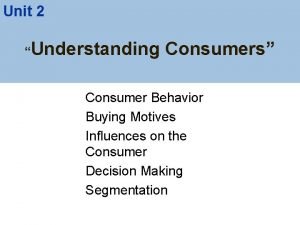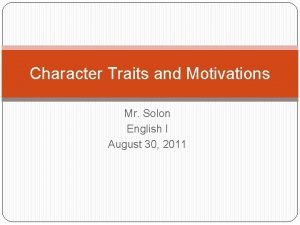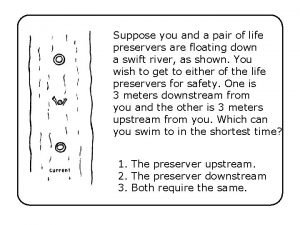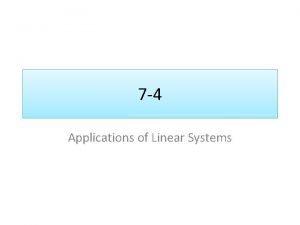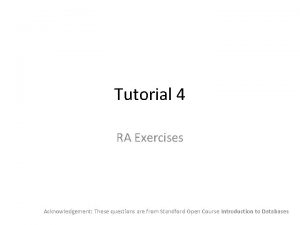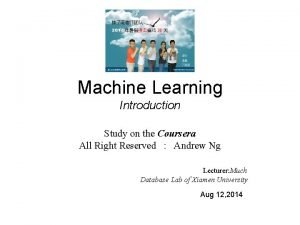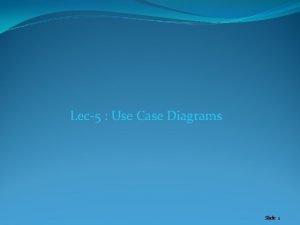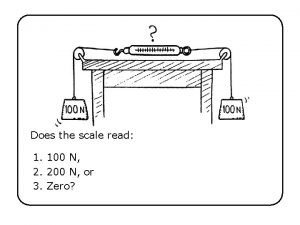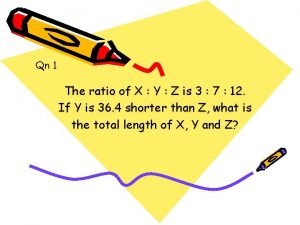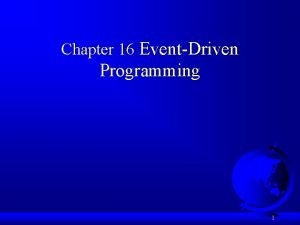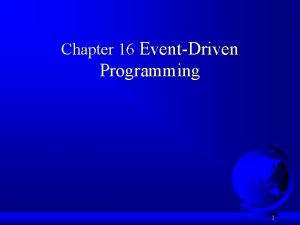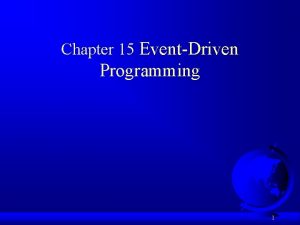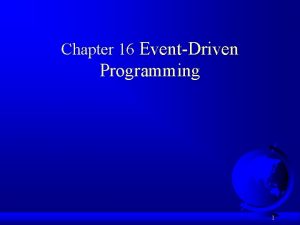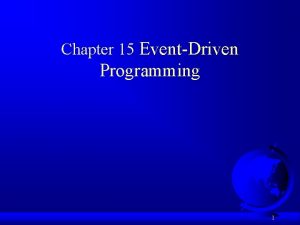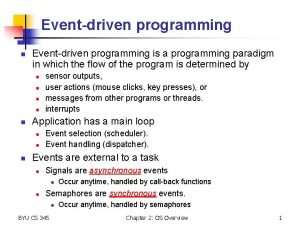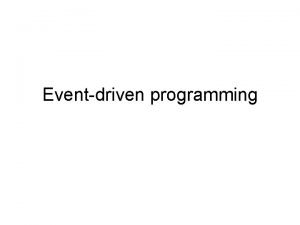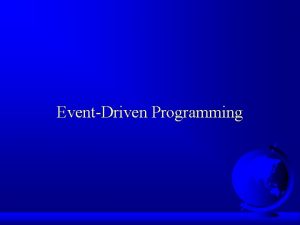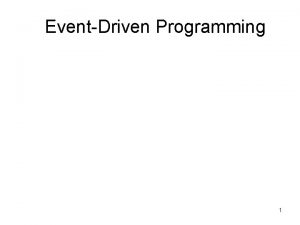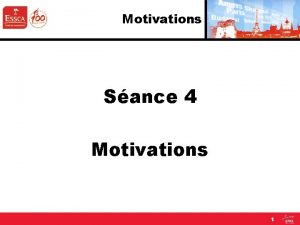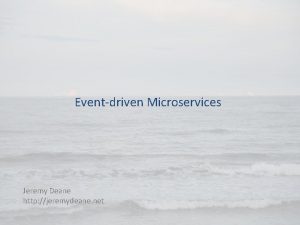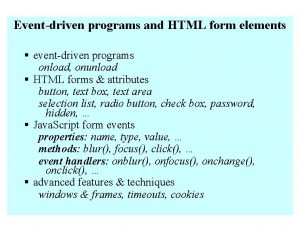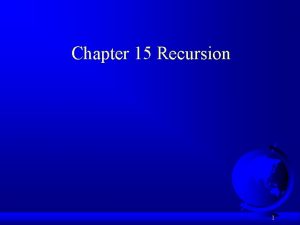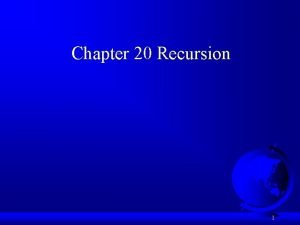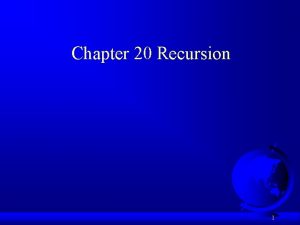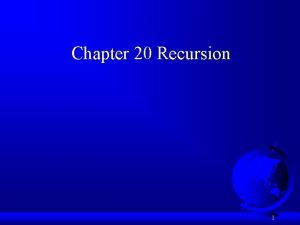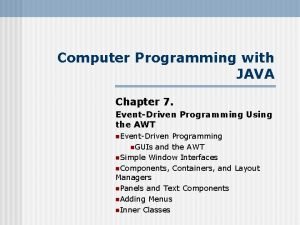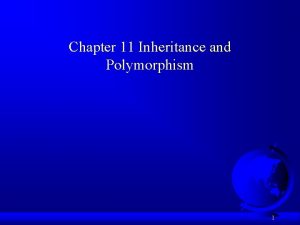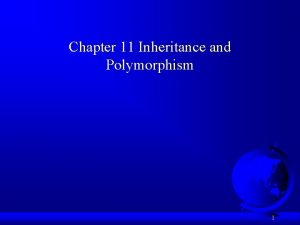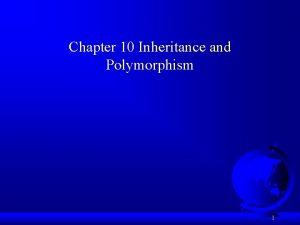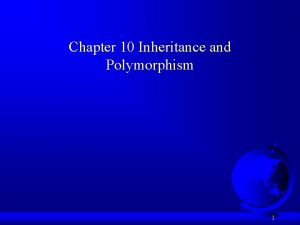Chapter 15 EventDriven Programming 1 Motivations Suppose you




































- Slides: 36

Chapter 15 Event-Driven Programming 1

Motivations Suppose you wish to write a program that animates a rising flag, as shown in Figure 15. 1. How do you accomplish the task? There are several solutions to this problem. An effective way to solve it is to use event-driven programming, which is the subject of this chapter. 2

Objectives F F F To explain the concept of event-driven programming (§ 15. 2). To understand events, event sources, and event classes (§ 15. 2). To declare listener classes and write the code to handle events (§ 15. 3). To register listener objects in the source object (§ 15. 3). To declare inner classes and anonymous inner classes (§ 15. 3. 115. 3. 2). To create listeners using inner classes and anonymous inner classes (§ 15. 3. 2). To understand how an event is handled (§ 15. 3). To write programs to deal with Action. Event (§ 15. 3). To write programs to deal with Mouse. Event (§ 15. 4). To write programs to deal with Key. Event (§ 15. 5). To use the Timer class to control animations (§ 15. 6). 3

Procedural vs. Event-Driven Programming F Procedural programming is executed in procedural order. F In event-driven programming, code is executed upon activation of events. 4

Revisit Listing 11. 7 Taste of Event-Driven Programming F The example displays a button in the frame. A message is displayed on the console when a button is clicked. Handle. Event Run 5

Events F An event can be defined as a type of signal to the program that something has happened. F The event is generated by external user actions such as mouse movements, mouse clicks, and keystrokes, or by the operating system, such as a timer. 6

Event Classes 7

Event Information An event object contains whatever properties are pertinent to the event. You can identify the source object of the event using the get. Source() instance method in the Event. Object class. The subclasses of Event. Object deal with special types of events, such as button actions, window events, component events, mouse movements, and keystrokes. Table 15. 1 lists external user actions, source objects, and event types generated. 8

Selected User Actions User Action Source Object Event Type Generated Click a button Click a check box Click a radio button JButton JCheck. Box JRadio. Button Action. Event Item. Event, Action. Event Press return on a text field JText. Field Action. Event Select a new item JCombo. Box Item. Event, Action. Event Window opened, closed, etc. Window. Event Mouse pressed, released, etc. Key released, pressed, etc. Component Mouse. Event Key. Event 9

The Delegation Model 10

Internal Function of a Source Component 11

The Delegation Model: Example JButton jbt = new JButton("OK"); Action. Listener listener = new OKListener(); jbt. add. Action. Listener(listener); 12

Selected Event Handlers Event Class Listener Interface Listener Methods (Handlers) Action. Event Item. Event Window. Event Action. Listener Item. Listener Window. Listener Container. Event Container. Listener Mouse. Event Mouse. Listener Key. Event Key. Listener action. Performed(Action. Event) item. State. Changed(Item. Event) window. Closing(Window. Event) window. Opened(Window. Event) window. Iconified(Window. Event) window. Deiconified(Window. Event) window. Closed(Window. Event) window. Activated(Window. Event) window. Deactivated(Window. Event) component. Added(Container. Event) component. Removed(Container. Event) mouse. Pressed(Mouse. Event) mouse. Released(Mouse. Event) mouse. Clicked(Mouse. Event) mouse. Exited(Mouse. Event) mouse. Entered(Mouse. Event) key. Pressed(Key. Event) key. Released(Key. Event) key. Typeed(Key. Event) 13

java. awt. event. Action. Event Simple. Event. Demo Run 14

Inner Class Listeners A listener class is designed specifically to create a listener object for a GUI component (e. g. , a button). It will not be shared by other applications. So, it is appropriate to define the listener class inside the frame class as an inner class. 15

Inner Classes Inner class: A class is a member of another class. Advantages: In some applications, you can use an inner class to make programs simple. F An inner class can reference the data and methods defined in the outer class in which it nests, so you do not need to pass the reference of the outer class to the constructor of the inner class. Show. Inner. Class 16

Inner Classes, cont. 17

Inner Classes (cont. ) F Inner classes can make programs simple and concise. F An inner class supports the work of its containing outer class and is compiled into a class named Outer. Class. Name$Inner. Class. Name. class. For example, the inner class Inner. Class in Outer. Class is compiled into Outer. Class$Inner. Class. class. 18

Inner Classes (cont. ) F An inner class can be declared public, protected, or private subject to the same visibility rules applied to a member of the class. F An inner class can be declared static. A static inner class can be accessed using the outer class name. A static inner class cannot access nonstatic members of the outer class 19

Revisiting Simple. Event. Demo Using Inner Classes Simple. Event. Demo. Inner. Class Run 20

Anonymous Inner Classes F F An anonymous inner class must always extend a superclass or implement an interface, but it cannot have an explicit extends or implements clause. An anonymous inner class must implement all the abstract methods in the superclass or in the interface. An anonymous inner class always uses the no-arg constructor from its superclass to create an instance. If an anonymous inner class implements an interface, the constructor is Object(). An anonymous inner class is compiled into a class named Outer. Class. Name$n. class. For example, if the outer class Test has two anonymous inner classes, these two classes are compiled into Test$1. class and Test$2. class. 21

Anonymous Inner Classes (cont. ) Inner class listeners can be shortened using anonymous inner classes. An anonymous inner class is an inner class without a name. It combines declaring an inner class and creating an instance of the class in one step. An anonymous inner class is declared as follows: new Super. Class. Name/Interface. Name() { // Implement or override methods in superclass or interface // Other methods if necessary } 22

Revising Simple. Event. Demo Using Anonymous Inner Classes Anonymous. Listener. Class Run 23

Example: Controlling Balls F Objective: Use buttons to enlarge or shrink a ball. Control. Ball Run 24

Example: Handling Window Events F Objective: Demonstrate handling the window events. Any subclass of the Window class can generate the following window events: window opened, closing, closed, activated, deactivated, iconified, and deiconified. This program creates a frame, listens to the window events, and displays a message to indicate the occurring event. Test. Window. Event Run 25

Example: Multiple Listeners for a Single Source F Objective: This example modifies Listing 15. 1 to add a new listener for each button. The two buttons OK and Cancel use the frame class as the listener. This example creates a new listener class as an additional listener for the action events on the buttons. When a button is clicked, both listeners respond to the action event. Test. Multiple. Listener Run 26

Mouse. Event 27

Handling Mouse Events F Java provides two listener interfaces, Mouse. Listener and Mouse. Motion. Listener, to handle mouse events. F The Mouse. Listener listens for actions such as when the mouse is pressed, released, entered, exited, or clicked. F The Mouse. Motion. Listener listens for actions such as dragging or moving the mouse. 28

Handling Mouse Events 29

Example: Moving Message Using Mouse Objective: Create a program to display a message in a panel. You can use the mouse to move the message. The message moves as the mouse drags and is always displayed at the mouse point. Move. Message. Demo Run 30

Handling Keyboard Events To process a keyboard event, use the following handlers in the Key. Listener interface: F key. Pressed(Key. Event e) Called when a key is pressed. F key. Released(Key. Event e) Called when a key is released. F key. Typed(Key. Event e) Called when a key is pressed and then released. 31

The Key. Event Class F Methods: get. Key. Char() method get. Key. Code() method F Keys: Home VK_HOME End VK_END Page Up VK_PGUP Page Down VK_PGDN etc. . . 32

The Key. Event Class, cont. 33

Example: Keyboard Events Demo Objective: Display a user-input character. The user can also move the character up, down, left, and right using the arrow keys. Key. Event. Demo Run 34

The Timer Class Some non-GUI components can fire events. The javax. swing. Timer class is a source component that fires an Action. Event at a predefined rate. The Timer class can be used to control animations. For example, you can use it to display a moving message. Animation. Demo Run 35

Clock Animation In Chapter 14, you drew a Still. Clock to show the current time. The clock does not tick after it is displayed. What can you do to make the clock display a new current time every second? The key to making the clock tick is to repaint it every second with a new current time. You can use a timer to control how to repaint the clock. Clock. Animation Run 36
 Buying motivations
Buying motivations Imperialism asia
Imperialism asia Motivations for imperialism in asia
Motivations for imperialism in asia Yang dimaksud dengan motivasi interpersonal adalah...
Yang dimaksud dengan motivasi interpersonal adalah... Character traits and motivations
Character traits and motivations Samuel de champlain motivations
Samuel de champlain motivations John cabot
John cabot God glory gold
God glory gold Motivation for imperialism
Motivation for imperialism Gold god glory drawing
Gold god glory drawing English motivations for settlement
English motivations for settlement Suppose you live in a society that has a barter economy
Suppose you live in a society that has a barter economy Suppose you and a pair of life preservers
Suppose you and a pair of life preservers Suppose you tear open the corner of a bag of m&ms
Suppose you tear open the corner of a bag of m&ms The cask of amontillado critical thinking questions
The cask of amontillado critical thinking questions Suppose you are talking by interplanetary telephone
Suppose you are talking by interplanetary telephone But these aren't cheap labour
But these aren't cheap labour Suppose you want to combine two types of fruit drink
Suppose you want to combine two types of fruit drink Suppose q is the midpoint of pr
Suppose q is the midpoint of pr Perbedaan linear programming dan integer programming
Perbedaan linear programming dan integer programming Greedy algorithm vs dynamic programming
Greedy algorithm vs dynamic programming What is system programing
What is system programing Integer programming vs linear programming
Integer programming vs linear programming Programing adalah
Programing adalah You say that you love rain
You say that you love rain Eat meals that are nutritious agree or disagree
Eat meals that are nutritious agree or disagree If you think you can you can poem
If you think you can you can poem Tell me what you eat and i shall tell you what you are
Tell me what you eat and i shall tell you what you are I will follow you wherever you blank
I will follow you wherever you blank Suppose relation r(a b)
Suppose relation r(a b) Suppose your email program watches
Suppose your email program watches Suppose we want to develop software for an alarm clock
Suppose we want to develop software for an alarm clock Arnold strongman and suzie small each pull
Arnold strongman and suzie small each pull Suppose two waves collide and the temporary
Suppose two waves collide and the temporary Suppose an osprey eat 300g of fish per day
Suppose an osprey eat 300g of fish per day Guess believe
Guess believe Qn-1
Qn-1
